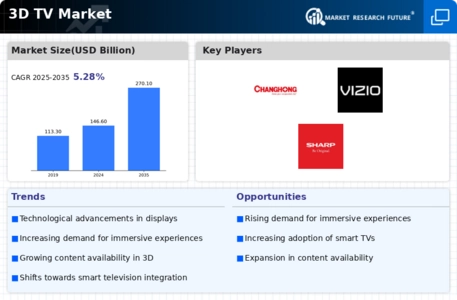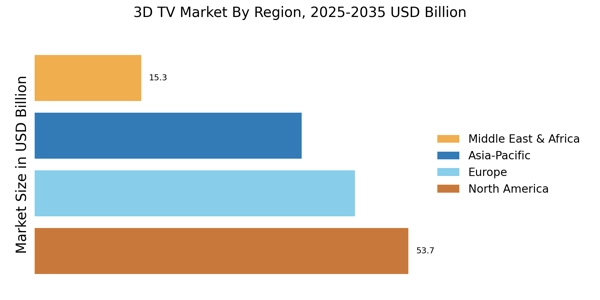Competitive Pricing Strategies
The 3D TV Market is also influenced by competitive pricing strategies adopted by manufacturers. As the market matures, companies are increasingly offering 3D TVs at various price points to attract a broader consumer base. This strategy not only makes 3D technology more accessible but also encourages consumers who may have been hesitant to invest in such technology. Recent market analysis indicates that the average price of 3D TVs has decreased by around 20% over the past two years, making them more appealing to budget-conscious consumers. This trend suggests that as pricing becomes more competitive, the market for 3D TVs could expand, potentially leading to increased sales and market penetration.
Advancements in Display Technology
The 3D TV Market is significantly influenced by advancements in display technology. Innovations such as OLED and QLED have improved the quality of 3D images, making them more vibrant and realistic. These technologies enhance color accuracy and contrast, which are crucial for delivering an immersive 3D experience. As manufacturers invest in research and development, the introduction of new display technologies is likely to attract consumers who prioritize high-quality visuals. Furthermore, the integration of 4K resolution in 3D TVs is becoming more prevalent, which may further drive sales as consumers seek superior picture quality. This technological evolution could potentially reshape consumer preferences in the 3D TV Market.
Increased Availability of 3D Content
The 3D TV Market is benefiting from the increased availability of 3D content across various platforms. Streaming services and digital platforms are expanding their libraries to include a wider range of 3D films, documentaries, and gaming options. This surge in content availability is likely to encourage consumers to invest in 3D televisions, as the value proposition of owning such a device becomes more appealing. Recent statistics indicate that the number of 3D titles available on major streaming platforms has increased by over 30% in the past year. This trend suggests that as more content becomes accessible, the demand for 3D TVs may continue to rise, further solidifying their place in the market.
Growing Interest in Home Entertainment Systems
The 3D TV Market is experiencing a surge in interest related to home entertainment systems. As consumers increasingly prioritize home entertainment, the demand for high-quality viewing experiences has escalated. 3D TVs are often seen as a centerpiece for home theaters, providing an enhanced viewing experience that traditional televisions may not offer. This trend is supported by data indicating that home theater system sales have risen by approximately 15% in the last year. As more households invest in comprehensive entertainment setups, the appeal of 3D televisions is likely to grow, suggesting a promising outlook for the market.
Rising Consumer Demand for Immersive Experiences
The 3D TV Market is witnessing a notable increase in consumer demand for immersive viewing experiences. As technology evolves, consumers are increasingly seeking entertainment options that provide a more engaging and lifelike experience. This trend is reflected in the growing popularity of 3D films and gaming, which have significantly contributed to the demand for 3D televisions. According to recent data, the market for 3D TVs is projected to grow at a compound annual growth rate of approximately 5% over the next five years. This indicates a robust interest in products that enhance visual experiences, suggesting that manufacturers may need to innovate continuously to meet consumer expectations.



















Leave a Comment